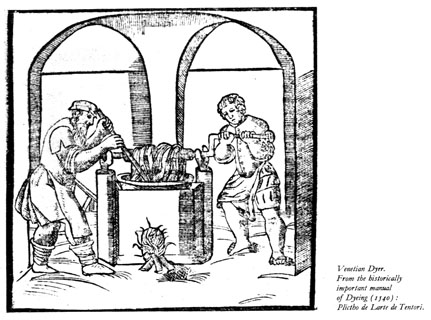 |
| http://www.pinterest.com/dianemanton/knights-astride-roosters/ |
I know, I know, I've spent lots of time on the trades connected to clothing, but they're so damn interesting. It was between this and a post about making inks or paint, but this seemed more useful for a writer of Fantasy (for some reason... in my head). So again, not the highest of the high. The dyer was a tradesmen. They were often organized into guilds to ensure the quality of their products and to pass on their secrets, which were jealously guarded. While not the most essential of occupations, the dyers bring a splash of color to life and helped to differentiate the nobles from the masses.
There are three basic ways to add color to an item, some more effective than others. Though usually unintentional, we have all stained a piece of clothing. This is simply rubbing or soaking an item without a chemical fixative, which temporarily imparts the intended color. The second is the use of an adhesive medium to affix the desired pigment to the material. The final, is the use of a true dye (like indigo), which deposits an insoluble form of the color from solution onto the material to be dyed. Yeah, it took folks a while to figure some of this stuff out.
Before dying, the fibers are often treated to improve their ability to absorb the dyes. Cellulose fibers (cotton or linen) were mordanted in washing sodas or tannins to create an alkaline bath. Protein fibers (wool, silk) were mordanted in alum and cream of tartar to create an acidic bath. Over the years an incredible variety of mordants have been used to achieve a variety of effects, including alum, copper and iron oxide. The efficacy of certain traditional mixtures may be questionable (much like traditional medicines), but it can be assumed that most of these folks weren't quite trained in scientific methodology.
The dyes themselves could be derived from almost anything. Plants, animals, insects, and even shellfish have been used to produce the colors we know and love. Peasants working out of their homes might use anything from their garden or surrounding countryside to give a splash of color to their garments. However, European dyers often used madder roots (red), woad leaves (blue), and weld seed capsules and leaves (yellow) for dyes, and in combination could produce any color they desired. However, there was a wide variety of other materials employed (see references).
Experimentation with colors and fixatives was common and most dyers would have their own methods and recipes involving a variety of ingredients, some more noxious than others. An English proclamation of 1587 restricted the size of woad fields and declared that their mills must be more than three miles from a royal residence, market town, or city, due to the highly offensive odor. Similarly, Venice (1413) prohibited woad or ox-blood dying after March 1, due to the unwholesome smell produced. As in the tanning trade, dyers were not shy about using urine and other less palatable materials to achieve their desired ends. Some experiments ended up killing the dyers and/or their clients, though arsenic produces a lovely green and coal tar can render a stunning mauve. Fashion is always a risky proposition.
Guilds were often very strong, limiting the dyes and processes available to the dyers dependent upon their rank within the guild. Legal strictures limiting dyers varied widely from country to country. In some places, it was illegal to own certain dying materials if you were not a member of the guild. Much like the merchants dealing in cloth, the dyers might have control over their entire branch of the industry, from farm to storefront. Precise methodologies and recipes were closely guarded secrets passed from master to apprentice. How some of the colors were achieved remains a mystery (though we can obviously figure out the chemical components).
The use of a dyer as a character in your world could take many forms. They might be the source of the maguffin (am I spelling that right?), sending your heroes on a quest to collect a specific material needed to produce a fantastic color (much like a wizard looking for a dangerous spell component). I seem to remember a dyer's apprentice in GRRM's big series, with blue hands (though he didn't live that long, but then you could say that about loads of his characters). The smells could add ambiance to your cities. The trade could be a significant aspect of local economy. The more you know about your world, the easier it is to find the stories to tell within it; after getting through all of this, I hope you add a little more color to yours.
 |
| http://www.elizabethancostume.net/cibas/ciba1.html |
World history (detailed) - http://kws.atlantia.sca.org/dyeing.html#
Modern dying using medieval European materials/recipes - http://www.medievaltextiles.org/news29.pdf
Brief (medieval) - http://www.medievalfreeco.org.uk/dyer.html
Deadly Fashion - http://io9.com/the-7-deadliest-fashion-trends-of-all-time-1595312875
Dye Sources - http://www.auxmaillesgodefroy.com/medieval_dyes
No comments:
Post a Comment